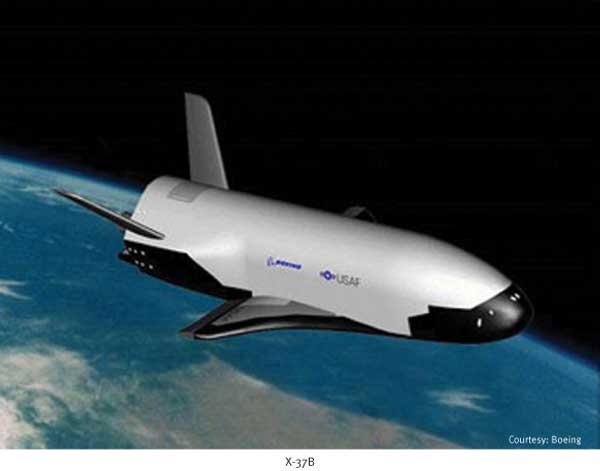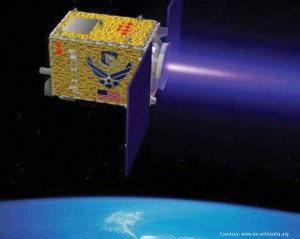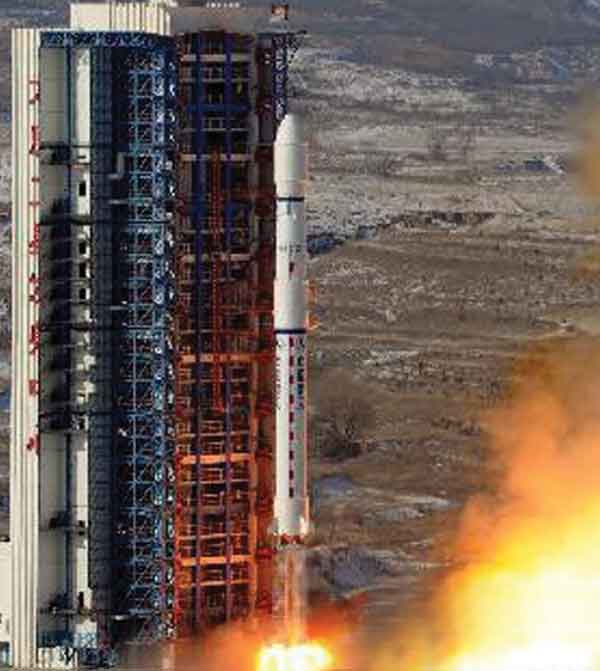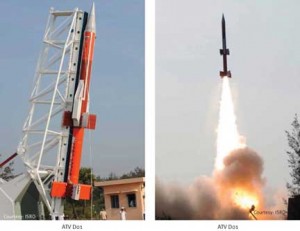History is witness to the fact that nations that have controlled the seas have ruled the world. With the passage of time, the ability to dominate the world progressively shifted into the hands of nations that acquired highly developed capabilities in military aviation with which they were able to establish mastery of the air. Indications are that in the future, those nations which would be able to extend their control over the regime of space will, in the final analysis, be the ones to control the earth.
It is not surprising therefore that leading space faring nations of today are engaged in a determined struggle to develop capabilities to push military weapons into space not only to safeguard their commercial assets orbiting the earth but also to develop the capability to influence or even directly control warfare in space, on land, sea or in the air.
…an Airborne Laser Test Bed carried onboard a modified Boeing 747 aircraft fired a megawatt-class Chemical Oxygen Iodine Laser Beam that successfully destroyed the target missile moving at over 5,000 km per hour.
It is therefore only a matter of time before the evolving doctrines of warfare will envelope space as a new dimension and seek to achieve synergy between military operations in space and those conducted closer to the earth’s surface. One of the new paradigms of warfare would be to significantly enhance the capabilities of conventional forces through the “Force Multiplier” effect with the use of space based weapons. This will undoubtedly further inspire the development of the newer, advanced and more lethal technologies thereby driving the world into an arms race qualitatively different from the variety witnessed in the twentieth century.
As agreements and treaties are generally feeble of fragile, the attendant risk of the breakout of war in space by default or design, could be real. In future wars, the capability to dominate and exploit the space regime could make the crucial difference between victory and defeat thus reorienting the focus of the development of new weapon systems hitherto unknown.
The race between the US and the Soviet Union to conquer space was triggered by the latter in 1957, with its launch of the Sputnik. This lasted at an intense pace till 1975, but this period was influenced by the Cold War and also witnessed a number of pioneering events including a landing on the moon. During the little over five decades that have gone by since the momentous event of 1957, the US, Russia, France, China, India, Germany and Japan have made rapid strides in developing space exploration capabilities.
Several smaller nations such as South Korea, Algeria, South Africa, Libya, Indonesia, Iran, Pakistan, North Korea are also believed to be in the process of acquiring or developing missile technologies, satellites and space launch capabilities purported to be for commercial exploitation of space. This list will only grow with the passage of time as the facility of commercial employment of space or scientific experimentation is freely available to all.
Ostensibly for civilian use, the technology associated with exploration of space in the pursuit of commercial interests, is quite easily adaptable for military use. Hence the dividing line between civilian and military application of assets for the exploitation of space, is usually blurred. Space thus could quite easily get militarised or weaponised unobtrusively and the possibility, that the new players emerging on the scene in the near future could well pose a serious threat to the leading space faring nations of today, can become a reality.
…it is believed that some US intelligence satellites transiting over Chinese territory were targeted by high powered ground-based laser weapons believed to be located in China.
Thus, space would undoubtedly emerge as the military high ground in the future.
Space Warfare
The range of capabilities that a nation aspiring to be a credible space military power would need to develop is quite similar to the pattern applicable to warfare on land, sea or in the air. Firstly, the aspect of “Space Denial” which implies that a nation must have the capability through direct action by space based or even ground, sea or aircraft based weapon systems to prevent the adversary actual or potential, from using the medium of space for military purposes thus denying him the advantage of force multipliers and military high ground while simultaneously ensuring freedom of action by friendly elements in space.
Space weapons of the enemy would include any platform or system for ultimate military use such as long range ballistic missiles, satellites and their launch vehicles or reusable space vehicles. Secondly, there must be the ability to destroy using space-based weapons, enemy targets of concern already deployed and operational in space such as satellites or installations on the surface of the earth or any weapons system such as beam weapons that could be deployed in the future in space or on any other heavenly body. Thirdly, the nation must have the capability to secure its assets in space through capable “Space Defence” somewhat akin to the concept of Air Defence of earth-based assets.
Space warfare capabilities are applicable across the range of conflict scenarios both at the strategic and tactical levels, serving most effectively as “deterrence” or to bring about a speedy conclusion to a ground war. In the prevailing scenario, space based assets i.e. satellites for military use are employed for purposes of reconnaissance, surveillance, communications, navigation, monitoring of weather and a variety of alert warnings. Some of these activities such as reconnaissance and surveillance are carried out by satellites placed in Low Earth Orbits (LEO) that are polar, and are in the nature of intelligence gathering thereby enhancing the speed and accuracy of decision making at all levels of command. Development of anti-satellite weapon systems is likely to render satellites in LEO quite vulnerable.
Facility for global communication without dependence on elaborate infrastructure on the ground is provided by satellites placed in Geosynchronous Equatorial Orbits at around 40,000 km from the surface of the earth over the Equator and compared to satellites in LEO that are less than 2,000 km from the surface of the earth, would be far more difficult to destroy.
For a nation that places heavy reliance on space-based facilities for communications, loss of a few key satellites through destruction or blinding, could disrupt command and control leading to paralysis in the system and seriously undermining conventional military operations.
Vehicles for Space Combat
The concept of employment of combat aircraft is not a new one. As early as 1930, Germany had developed a design of a rocket powered sub-orbital bomber aircraft called the Silverbogel that never flew. After the war, a project in the US, based on the German design designated as X-20 Dyna Soar, was initiated but later cancelled. However, other programmes for space reusable vehicles or space planes followed. These were the X-40 A Space Manoeuvre Vehicle that flew in 1998, the X-34 that was cancelled due to high cost overruns and the X-43, NASA’s Research Vehicle. The most successful but expensive programme so far for reusable vehicle has been the US Space Shuttle programme of the seventies.
Essentially a Space Transportation System with no overt military agenda, the programme was marred by two major disasters with heavy loss of life. It is to be replaced by the Orion programme. The Russian equivalent was the Buran that flew in 1988. The programme was cancelled five years later due to financial stringency and in 2002, the vehicle was destroyed in a hangar collapse. There are no signs of revival of the project so far.
Earlier this year, the US launched its latest robotic space plane, the X-37B produced by Boeing Phantom Works. As the first actual unmanned combat aircraft in space, it is a forerunner of things to come. With the looks of a miniature Space Shuttle, the X-37B is a fully automated vehicle capable of loitering in space for up to nine months after launch and then re-enter the earth’s atmosphere for an automated landing on a runway. This aircraft will not only test and validate next generation reusable technologies for satellites but will also pave the way for further development of combat aircraft capable of operating in space. This machine signals a clear shift of emphasis from missiles to fixed wing platforms for space ventures.
Weapons in Space
In the beginning of this year, an Airborne Laser Test Bed carried onboard a modified Boeing 747 aircraft fired a megawatt-class Chemical Oxygen Iodine Laser Beam that successfully destroyed the target missile moving at over 5,000 km per hour. This was the first time ever that a missile in flight has been destroyed by laser. This weapon system would have the potential to target satellites in orbit as well. Unfortunately, success seems to have come a little too late as the programme, already buckling under the weight of cost overrun, is unlikely to be sustained to reach operational status. Robert Gates, the US Defence Secretary described the concept as “fatally flawed” although it was not clear why.
“…if we are to play a meaningful role nationally and in the comity of nations, we must be second to none in the application of advanced technologies” — Vikram Sarabhai 02 Feb 1968.
Research in the development of weapons systems to destroy satellites in space began in the 1950s and a variety of options such as blinding of satellites through nuclear explosion in space and nuclear powered X-Ray laser were examined. A number of missile-based projects were launched but with little success.
Development of an Anti Satellite (ASAT) missile system was on the backburner till 1982 when in response to reports of successful development of a similar weapons systems in the Soviet Union; the US developed the Vought ASM 135, an ASAT to be delivered by an F15 combat aircraft. With the maiden trial launch in 1984, the first successful firing culminating in intercept by the ASAT was recorded on September 13, 1985 against the Solwind P78-1, a defunct US satellite. In 1988, the ASAT programme was cancelled.
However, on February 14, 2008, ASAT capability of a somewhat lower level was demonstrated by the US Navy when it fired an SM 3 ABM weapon in the role of an ASAT and successfully destroyed a defunct American spy satellite 247 km above the surface of the earth. An SM 3 does not have the range to intercept satellites in Low Earth Orbit, which is much higher that the impact point in this case. But as the orbit of the satellite was decaying rapidly, it fell within range of the SM 3.
Research and Development activities in respect of ASAT programmes began to generally slow down in the US owing to deep cuts in expenditure. However, of late, it appears that a number of new programs such as the Experimental Spacecraft System or XSS 11 and the Space Based Interceptor (SBI), possibly related to space-based ASAT are underway.
Soviet Space Weapons
During the Cold War, the satellite launch capabilities of the Soviet Union were as good, if not better, than that of the US. Research in the Soviet Union on the development of space related weapon systems was proceeding more or less on track parallel to that in the US. In 1961, the Soviet Union undertook the development of an Interceptor Satellite (IS). The concept involved launching the killer satellite into the same orbit as the target satellite. Thereafter, the requirement was to manoeuvre the killer satellite into the vicinity of the target, say about less than a kilometre, to be destroyed by shrapnel generated through explosion of a warhead on the killer satellite. Declared operational in 1973 after extensive testing, the programme was formally closed down in 1983 and has not been heard of since then.
In the 1970s and 1980s, there were reportedly cases of US Spy Satellites being temporarily blinded for inexplicable reasons. The needle of suspicion naturally pointed to the Soviet Union. Soviet scientists also dabbled with research in Charged Particle Beam Weapon System and possible use of space stations as launch platforms for weapons against satellites in orbit. However, these efforts did not meet with much success. In the 1980s, the Soviet Union did develop an ASAT System using the MiG 31 aircraft as the launch platform.
Backed by her (China) powerful national will and immense resources, China’s plans to put a man on the moon by 2024 will, in all likelihood, succeed.
There is not much clarity on the level of Chinese success in the development of ASAT capability as their activities continue to be shrouded in secrecy. However, as per reports appearing in the media, China appears to have a laser weapons system deployed in Xinjiang province, though details of its power output and overall capability to blind or destroy a satellite is not known with any degree of certainty. In August 2006, it is believed that some US intelligence satellites transiting over Chinese territory were targeted by high powered ground-based laser weapons believed to be located in China.
The efficacy of the laser weapon has not been revealed and in fact doubts linger as to whether the supposedly directed beam was meant to temporarily neutralise the satellite or whether it was part of a ground-based missile guidance system. On January 11, 2007, in a live test of a ground-based SC 19 ASAT, China successfully destroyed one of its own life expired weather monitoring satellites in a polar orbit at an altitude of over 650 km from the surface of the earth. Quite understandably, there was global concern over this development, not only on account of the strategic implications of the escalating arms race in space but also on account of the vast quantities of debris generated by the destruction of the satellite.
Space is being polluted by man-made debris at an alarming rate and as yet, there is no known technology or method for the removal of debris orbiting in space.
China is aggressively seeking foreign collaboration in her efforts to develop ground-based ASAT capability both through hard and soft kill as also the facility to track satellites in Low Earth Orbit and interfere with transmissions from space-based platforms such as the existing Global Positioning System or future navigation systems such as the European Galileo or the Russian GLONASS.
Given China’s determination and national focus on emerging as a superpower, there should be little doubt about her intentions to remain abreast of, if not ahead, in the emerging arms race in space. China’s ambitions to be second to none in the space race can be gauged from the fact that she has already sent several astronauts into space albeit a little later than others.
Backed by her powerful national will and immense resources, China’s plans to put a man on the moon by 2024 will, in all likelihood, succeed.
India’s Space Endeavour
The Indian space programme, which began in 1962 at the Thumba Equatorial Launching Station located near a seaside fishing hamlet on the Kerala coast, was formally inaugurated on November 21, 1963 with the launch of an American-manufactured Nike Apache sounding rocket. However, the seeds of the truly indigenous space programme were sown by the launch of a `pencil rocket` 10 kg in weight carrying 350 grams of fuel, just a few kilometres into the sky. The largest space launch vehicle with the Indian Space Research Organisation (ISRO) today is the Geosynchronous Satellite Launch Vehicle (GSLV) which is around 50 metres tall and has a lift off weight in excess of 400 tonnes.
For about five decades, ISRO has recorded some remarkable successes as also a few spectacular failures that are not uncommon in space exploration. Remarkably, ISRO has learnt quickly and each time successfully turned defeat into victory. With its first satellite launch in 1975, to date ISRO can be credited with sending around 40 satellites into orbit, which includes 16 on behalf of foreign customers.
However, despite decades of scientific endeavour, colossal investments and notable successes in the exploration of space, no nation has as yet an effective or proven space-based weapon and truly operational space combat capability.
On February 02, 1968, Vikram Sarabhai, regarded as Father of the Indian Space Programme, defined the focus of the Indian space endeavour in the following words, “There are some who question the relevance of space activities in a developing nation. To us, there is no ambiguity of purpose. We do not have the fantasy of competing with the economically advanced nations in the exploration of the moon or the planets or manned space flights. But we are convinced that if we are to play a meaningful role nationally and in the comity of nations, we must be second to none in the application of advanced technologies to the problem of man and society which we find in our economy.”
Since the enunciation by Vikram Sarabhai of what can be regarded as policy, in the last four decades, achievements by ISRO and their future programmes indicate that there has been a clear departure from India’s position stated initially. The successful first commercial launch on April 23, 2007 was indeed the turning point wherein ISRO inserted into orbit an Italian satellite with the help of the Polar Satellite Launch Vehicle (PSLV) which is the primary workhorse of the space agency with a payload capacity of around 1.7 tonnes.
With the successful development of the larger and more powerful GSLV, ISRO has the capability of inserting two-ton payload into geo-synchronous orbit. However, with the successful test of the S200 solid fuel booster early this year, the third most powerful in the world, payload capability for a geo-synchronous transfer orbit will be enhanced to four tonnes and ten tonnes for a near-earth orbit at an altitude of about 300 km.
After the experience gained from the partially successful moon mission Chandrayaan I, ISRO is moving forward with the second moon mission designated as Chandrayaan II scheduled for launch in 2013. This mission will consist of a Lunar Lander that, after a soft landing on the surface of the moon, will discharge a rover to collect rock and soil samples for chemical analysis. Chandrayaan II would be followed by launch of a week-long manned space mission in 2016 which will have a capsule designed to carry two Indian astronauts into space.
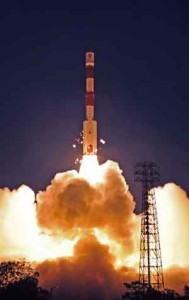 ISRO plans to establish a training facility for astronauts as also an additional launch pad at Sriharikota in Andhra Pradesh. Further, intentions are to land a man on the moon by 2020, and then to undertake deeper forays into space beginning with the exploration of Mars as well as conduct studies on the concept of a lunar base.
ISRO plans to establish a training facility for astronauts as also an additional launch pad at Sriharikota in Andhra Pradesh. Further, intentions are to land a man on the moon by 2020, and then to undertake deeper forays into space beginning with the exploration of Mars as well as conduct studies on the concept of a lunar base.
ISRO has a variety of ongoing and future satellite launch programmes in the civilian domain such as for monitoring of forest fires, study of greenhouse gases, vegetation and disaster management. Cartostat series of remote sensing earth observation satellites are launched periodically in polar orbit for mapping. INSAT series of communication satellites are parked in geo-stationary orbits to provide Direct-To-Home (DTH) countrywide satellite television coverage, telecommunications and sat-phone services, distant education, telemedicine facilities, broadband connectivity ATMs and cellular phone services.
In an effort to introduce new technologies, ISRO has recently tested a new generation high performance sounding rocket designated as the Advanced Technology Vehicle (ATV D01). Weighing three tonnes at lift off, the ATV D01 is designed to test futuristic air breathing propulsion technology. The ATV D01 was fitted with a passive Supersonic Combustion Ramjet (Scramjet) engine combustor module. This technology has the potential to reduce launch costs substantially as it derives the oxygen required for combustion from the atmosphere thus reducing the weight of fuel to be carried.
From the experience so far, it appears that with available technology, the concept of placing beam weapons on space-based platforms is likely to continue to remain a distant possibility.
As a purely commercial effort, in January 2009, amidst much controversy, ISRO launched a surveillance satellite for Israel designated as TecSAR. Few months later, ISRO launched a 300-kg Radar Imaging Satellite (RISAT2) built by Israel Aerospace Industries for India. Inserted into a 550 km orbit around the earth, the RISAT2 is the first imaging satellite with Synthetic Aperture Radar (SAR) deployed by India. The SAR gives the satellite all weather day and night surveillance capability.
Apart from the normal functions of an imaging satellite, the RISAT2 has defence applications, official denials notwithstanding. ISRO is developing its own version of SAR equipped surveillance satellite. Suitable for both civilian and military application, the RISAT2 will signify a quantum jump in the technological advancements so far achieved by ISRO.
Not to be left behind, ISRO, along with DRDO and other research institutions, is in the process of developing as a Technology Demonstrator, a 25 tonne reusable aircraft capable of operating from conventional airfields. Designated as Aerobic Vehicle for Hypersonic Aerospace Transportation nicknamed AVATAR, it would provide a low cost option for launch of military and civilian satellites. Powered by a Scramjet, it will be capable of delivering a satellite payload of up to one tonne into a 100-km earth orbit.
Indian ASAT
With India’s assets in space proliferating and disconcerting developments in the neighbourhood on the rise, it is only logical that India would have to adopt appropriate measures to provide adequate safeguards for her space assets as well as effective countermeasures against potential threats. Indian scientific establishments are currently engaged with the development of weapon systems for “electronic or physical destruction of satellites in both Low Earth Orbit and the higher Geo-synchronous Earth Orbits as part of the Indian Ballistic Missile Defence Program expected to be in place by 2014.
Conclusion
There is little doubt that space is the final frontier and control of the next military high ground not only to protect own assets in space but also to prevent potential adversaries in wresting advantage will be the new imperatives in space not only for the superpowers but other nations aspiring to use space for peaceful purposes. Space superiority like Air Superiority will be the sine qua non for domination of space in the centuries ahead.
However, despite decades of scientific endeavour, colossal investments and notable successes in the exploration of space, no nation has as yet an effective or proven space-based weapon and truly operational space combat capability. The ongoing programmes are yet in the experimental stage.
The space endeavour by nations has been constrained by two major factors – infinite technological complexity of programmes and not easily affordable costs. From the experience so far, it appears that with available technology, the concept of placing beam weapons on space-based platforms is likely to continue to remain a distant possibility. Challenges before space-faring nations to prepare for warfare in space will thus be formidable and daunting, at least in the foreseeable future.




